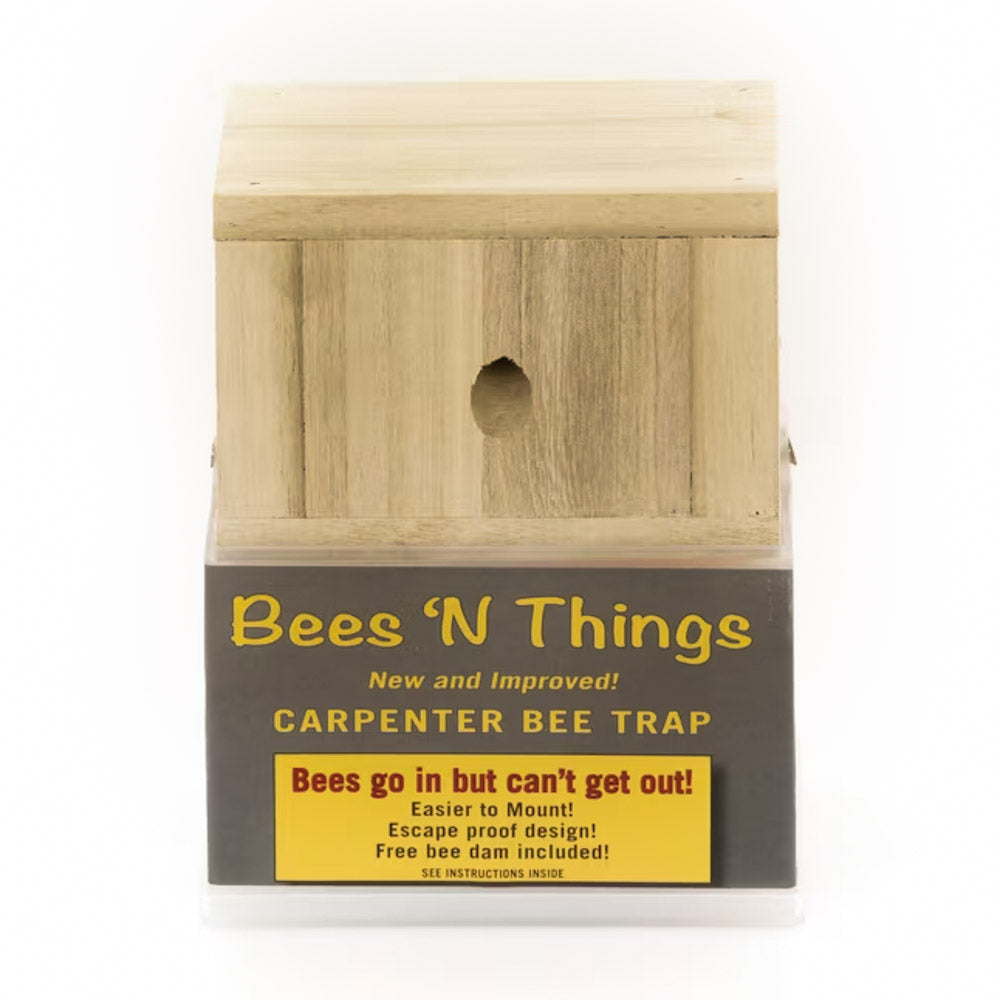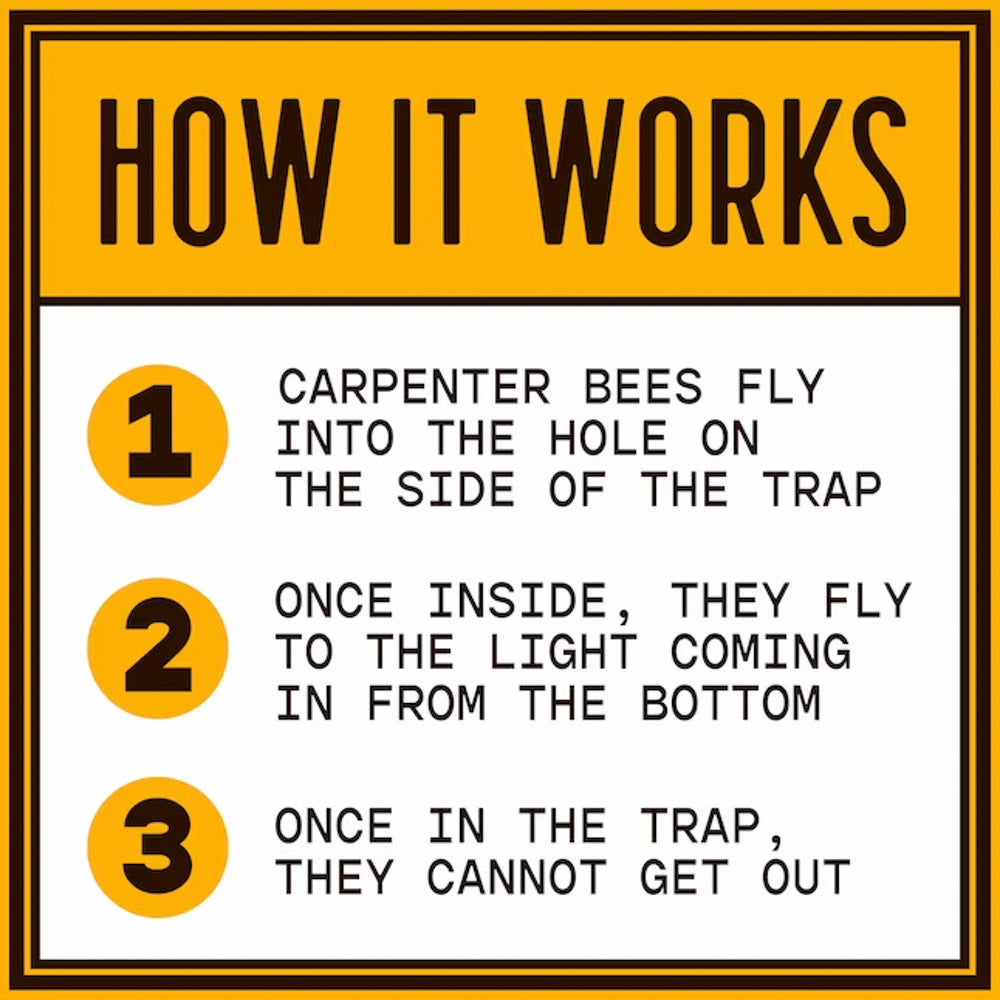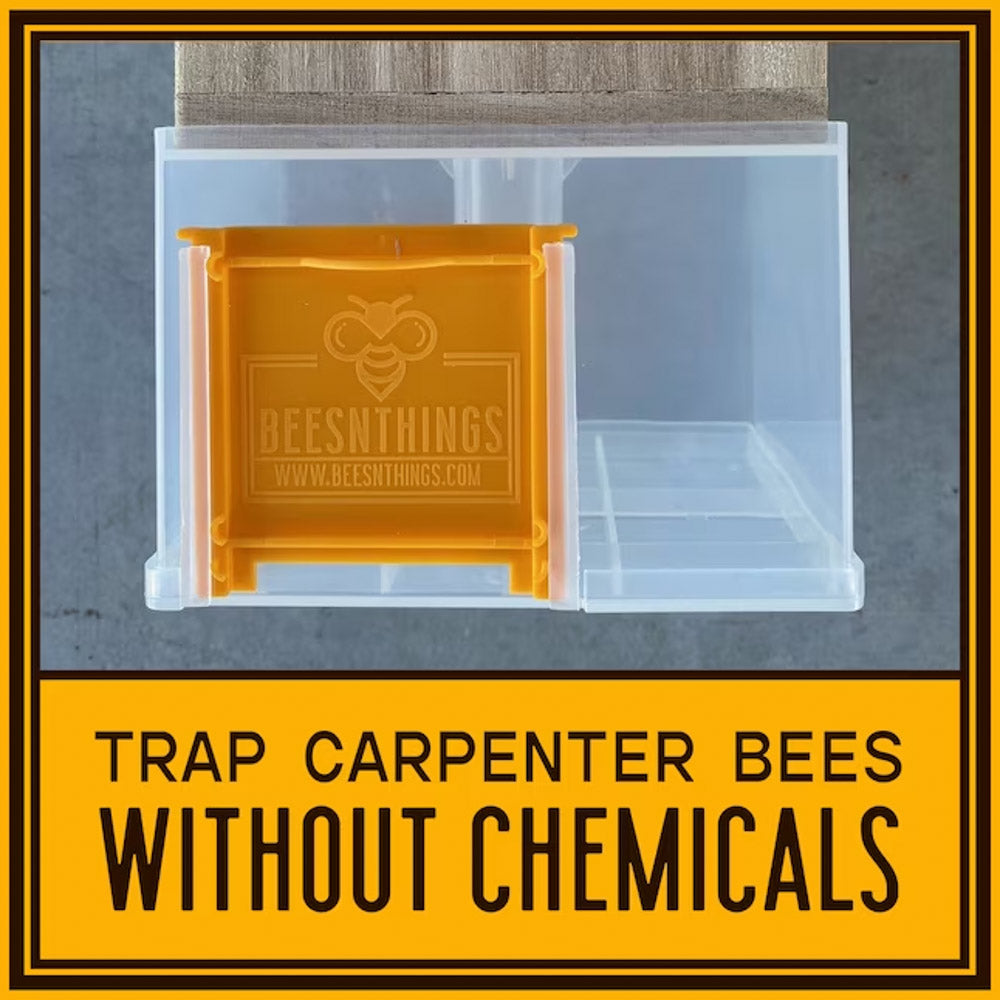A carpenter bee trap is a device designed to catch and control carpenter bees, which are wood-boring insects that can cause damage to wooden structures. Here's how a typical carpenter bee trap works and some considerations for using one:
Read more...
Read more...
Design: Carpenter bee traps are typically constructed of wood or plastic and feature a chamber or container where bees are lured in and trapped. The trap may have multiple entry points or funnels that lead into the chamber, along with a mechanism to prevent the bees from escaping once they enter.
Bait: Carpenter bee traps use bait to attract the bees into the trap. Common bait materials include untreated wood, such as pine or cedar, which carpenter bees are naturally attracted to for nesting. Some traps may also include additional attractants, such as pheromones or scents, to enhance their effectiveness.
Placement: Carpenter bee traps should be strategically placed in areas where carpenter bees are active or where wood damage has been observed. Ideal locations include near eaves, soffits, decks, fences, or other wooden structures where carpenter bees are known to nest. Traps can be hung from a hook or nail, mounted on a post or fence, or placed on flat surfaces.
Maintenance: Regular maintenance of carpenter bee traps is important to ensure their effectiveness. Traps should be checked regularly to remove captured bees and reset as needed. Bait materials may need to be replaced periodically, especially if they become weathered or less attractive to bees over time.
Overall, carpenter bee traps can be a useful tool for managing carpenter bee populations and protecting wooden structures from damage. By understanding how traps work and following best practices for placement and maintenance, homeowners can effectively reduce carpenter bee activity and minimize wood damage.
Settlemyre Nursery
Carpenter Bee Trap
Carpenter Bee Trap
SKU:BEETRAP
30 in stock
Local Pickup
1-2 Business Hours
Local Delivery
1-2 Business Days
Within 60 miles
*Selection made at checkout*
WE DO NOT SHIP
Couldn't load pickup availability
A carpenter bee trap is a device designed to catch and control carpenter bees, which are wood-boring insects that can cause damage to wooden structures. Here's how a typical carpenter bee trap works and some considerations for using one:
Read more...
Read more...
Design: Carpenter bee traps are typically constructed of wood or plastic and feature a chamber or container where bees are lured in and trapped. The trap may have multiple entry points or funnels that lead into the chamber, along with a mechanism to prevent the bees from escaping once they enter.
Bait: Carpenter bee traps use bait to attract the bees into the trap. Common bait materials include untreated wood, such as pine or cedar, which carpenter bees are naturally attracted to for nesting. Some traps may also include additional attractants, such as pheromones or scents, to enhance their effectiveness.
Placement: Carpenter bee traps should be strategically placed in areas where carpenter bees are active or where wood damage has been observed. Ideal locations include near eaves, soffits, decks, fences, or other wooden structures where carpenter bees are known to nest. Traps can be hung from a hook or nail, mounted on a post or fence, or placed on flat surfaces.
Maintenance: Regular maintenance of carpenter bee traps is important to ensure their effectiveness. Traps should be checked regularly to remove captured bees and reset as needed. Bait materials may need to be replaced periodically, especially if they become weathered or less attractive to bees over time.
Overall, carpenter bee traps can be a useful tool for managing carpenter bee populations and protecting wooden structures from damage. By understanding how traps work and following best practices for placement and maintenance, homeowners can effectively reduce carpenter bee activity and minimize wood damage.
Helpful Plant Nursery Information:
-
Why Settlemyre Nursery?
We know plants! Locally grown and sourced plant and tree material ensure that you are getting the best start for your garden or landscape. We have been building relationships for over 50 years.
-
Come see for yourself.
Folks travel from all over the western part of North Carolina to browse the our retail plant and tree nursery. We are so excited to help you! Plan a day to visit, bring the family, and come experience the difference!
-
Your Support.
When you support Settlemyre Nursery, you're not only supporting our business, you're contributing and supporting over 15 local families. From our family to yours, we say thank you.
Essentials
-
Bio-Tone Starter Plus Starter Fertilizer
Regular price From $3.99Regular priceUnit price / per$0.00Sale price From $3.99 -
 Best Seller
Best SellerRaised Bed Soil Mix
Regular price $10.99Regular priceUnit price / per$0.00Sale price $10.99 -
PermaTill - Permanent Aeration with Slate
Regular price From $12.99Regular priceUnit price / per$0.00Sale price From $12.99 -
 Delivery Available Back in Stock
Delivery Available Back in StockMulch - 1 Cubic Yard
Regular price $35.00Regular priceUnit price / per$0.00Sale price $35.00 -
36" Tree Diaper Round Mat
Regular price $49.99Regular priceUnit price / per$0.00Sale price $49.99 -
48" Tree Diaper Round Mat
Regular price $89.99Regular priceUnit price / per$0.00Sale price $89.99 -
24" Tree Diaper Round Mat
Regular price $34.99Regular priceUnit price / per$0.00Sale price $34.99 -
Pottery Water Jar Large 25 Atl Blue
Regular price $399.99Regular priceUnit price / per$0.00Sale price $399.99 -
 In-Store Only
In-Store OnlyAssorted Seed Packets
Regular price $2.99Regular priceUnit price / per$0.00Sale price $2.99 -
Pine Needle Bale
Regular price $6.99Regular priceUnit price / per$0.00Sale price $6.99 -
Jack's Classic Blossom Booster
Regular price $21.99Regular priceUnit price / per$0.00Sale price $21.99 -
 All Purpose
All PurposePlanting Soil Mix
Regular price $9.99Regular priceUnit price / per$0.00Sale price $9.99 -
Peat Moss 8lb
Regular price $19.99Regular priceUnit price / per$0.00Sale price $19.99 -
Wheat Straw Bale
Regular price $7.99Regular priceUnit price / per$0.00Sale price $7.99 -
Flower-tone Organic Fertilizer
Regular price $9.99Regular priceUnit price / per$0.00Sale price $9.99 -
Daddy Pete's Sea 'n Farm Soil Mix
Regular price $16.99Regular priceUnit price / per$0.00Sale price $16.99 -
 2 CF
2 CFHardwood Mulch
Regular price $6.99Regular priceUnit price / per$0.00Sale price $6.99 -
Holly Tone Organic Fertilizer
Regular price From $9.99Regular priceUnit price / per$0.00Sale price From $9.99 -
Plant-Tone Organic Fertilizer
Regular price From $9.99Regular priceUnit price / per$0.00Sale price From $9.99 -
Daddy Pete's Potting Soil Mix
Regular price $10.99Regular priceUnit price / per$0.00Sale price $10.99 -
 Gardens
GardensDaddy Pete's Organic Cow Manure
Regular price $7.99Regular priceUnit price / per$0.00Sale price $7.99 -
Berry-tone Organic Fertilizer
Regular price $10.99Regular priceUnit price / per$0.00Sale price $10.99 -
Rose-tone Organic Fertilizer
Regular price $10.99Regular priceUnit price / per$0.00Sale price $10.99 -
 Gardens
GardensMushroom Compost
Regular price $6.99Regular priceUnit price / per$0.00Sale price $6.99 -
Premium Planting Soil Mix - 1 Cubic Yard
Regular price $90.00Regular priceUnit price / per$0.00Sale price $90.00

































